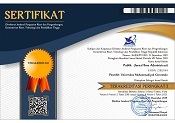Tourism Management Policy: Division of Makassar City Culinary Area
Abstract
Tourism development has a significant role in the development of economic, social, cultural, environmental, political and security aspects. The purpose of this study was to determine the distribution of the culinary area of Makassar City. The development of the tourism sector and its supports has an important meaning in national integration. Infrastructure not only serves to bind the geography of the archipelago, but also guides the birth of participation, efficiency and welfare This study uses a qualitative method. The results of this study indicate that the division of the culinary area in the city of Makassar is divided into 3 parts of the culinary area, namely Datu Museng Makassar City, Culinary Area of Perintis Kemerdekaan Street and Culinary Area of Sultan Alauddin Street. These three areas have their respective culinary icons. The culinary area of Datu Museng, Makassar, has a variety of culinary delights such as seafood, epe bananas, konro, otak-otak-pallu butung, pallu basa and others. While in the culinary area, the pioneering street of independence, the culinary icon is Mie Titi. Next, the culinary area of Jalan Sultan Alauddin icon is Coto Alauddin. Makassar's traditional culinary potential has a very big opportunity to develop, especially if it is associated with tourism which triggers interest in visits, regional income and the community. With an effective regional division, culinary will support the economy in Makassar City.
Keywords
Full Text:
PDFReferences
Akib, E. (2020). Pariwisata Dalam Tinjauan Pendidikan: Studi Menuju Era Revolusi Industri. Pusaka: Journal of Tourism, Hospitality, Travel and Business Event, 2(1), 1-7.
Besra, E. (2015). Potensi wisata kuliner dalam mendukung pariwisata di kota Padang. Jurnal Riset Akuntansi dan Bisnis, 12(1).
Hasbi, E. N. (2016). Pusat Wisata Kuliner di Kota Makassar (Doctoral dissertation, Universitas Islam Negeri Alauddin Makassar).
Hubeis, M., & Dewi, W. K. (2019). Kuliner: Suatu Identitas Ketahanan Pangan Unik. PT Penerbit IPB Press.
Kuncoro, M. (2018). Perencanaan Pembangunan. Gramedia Pustaka Utama.
Nirwandar, S. (2011). Pembangunan sektor pariwisata di era otonomi daerah. Diakses pada, 24.
Rijal, S. (2021) Penelitian Mandiri-Kuliner Tradisional Sebagai Daya Tarik Kota Makassar Sebagai Destinasi Wisata Kuliner. repository.poltekparmakassar.ac.id
Riyadi, A. (2017). Desain Koridor Jalan Nusantara sebagai Pusat Wisata Kota Makassar (Doctoral dissertation, Fakultas Sains dan Teknologi).
Safitri, K. A. (2019). Pengembangan wisata di Kabupaten Buru Menggunakan Analisis SWOT. Jurnal Sosial Humaniora Terapan, 1(2).
Surya, B., Idris, M., & Lasmana, L. (2019). Pusat Kuliner Jalan Nusantara Kota Makassar. Jurnal Inovasi dan Pelayanan Publik Makassar, 1(1), 24-36.
Syamsul Rahman, S. T. P. (2021). Pengembangan industri kuliner berbasis makanan tradisional khas Sulawesi. Deepublish.
Article metrics
Refbacks
- There are currently no refbacks.
Copyright (c) 2021 Publik (Jurnal Ilmu Administrasi)

This work is licensed under a Creative Commons Attribution-ShareAlike 4.0 International License.

Publik (Jurnal Ilmu Administrasi) is licensed under a Creative Commons Attribution-ShareAlike 4.0 International License.










